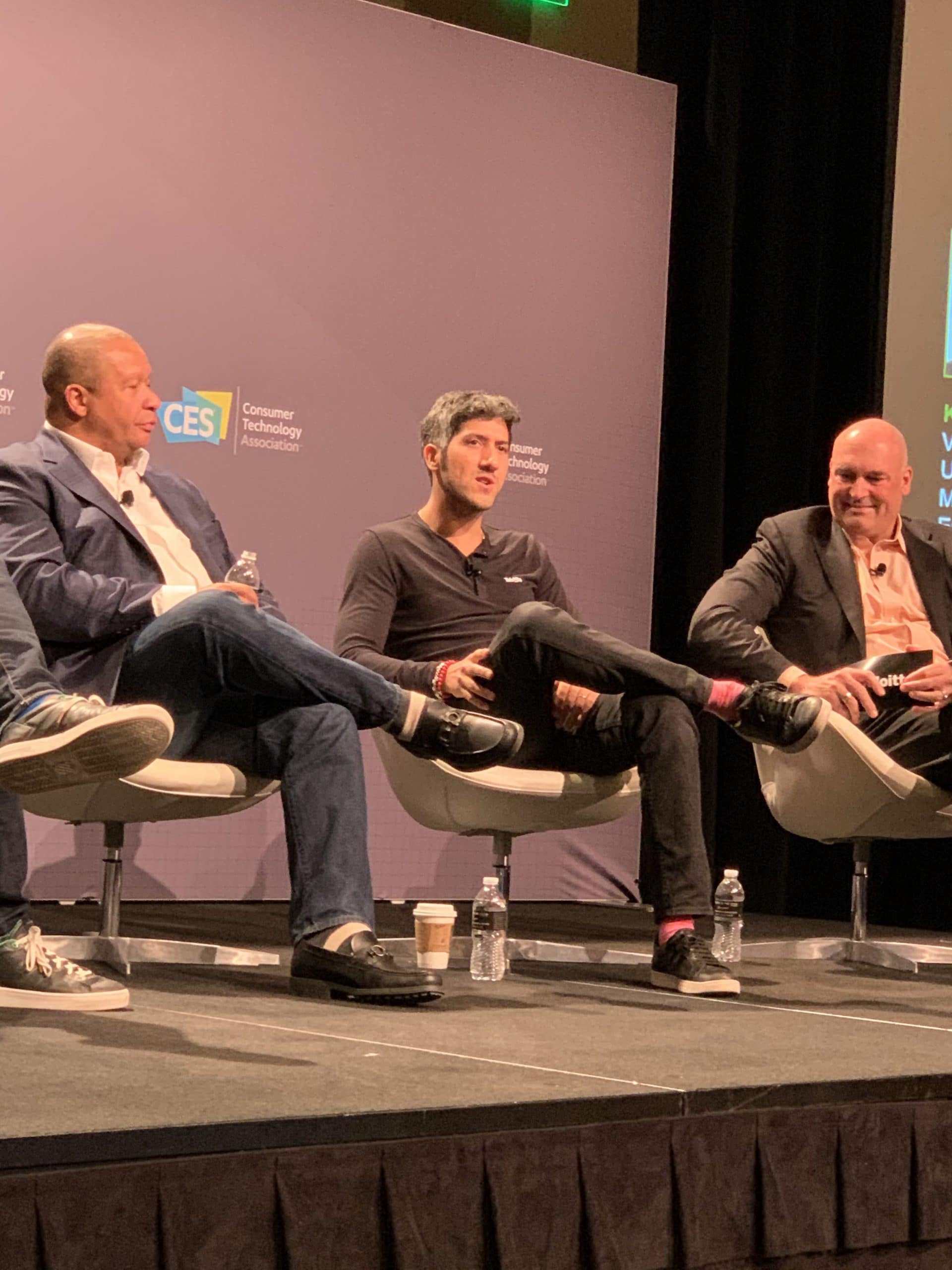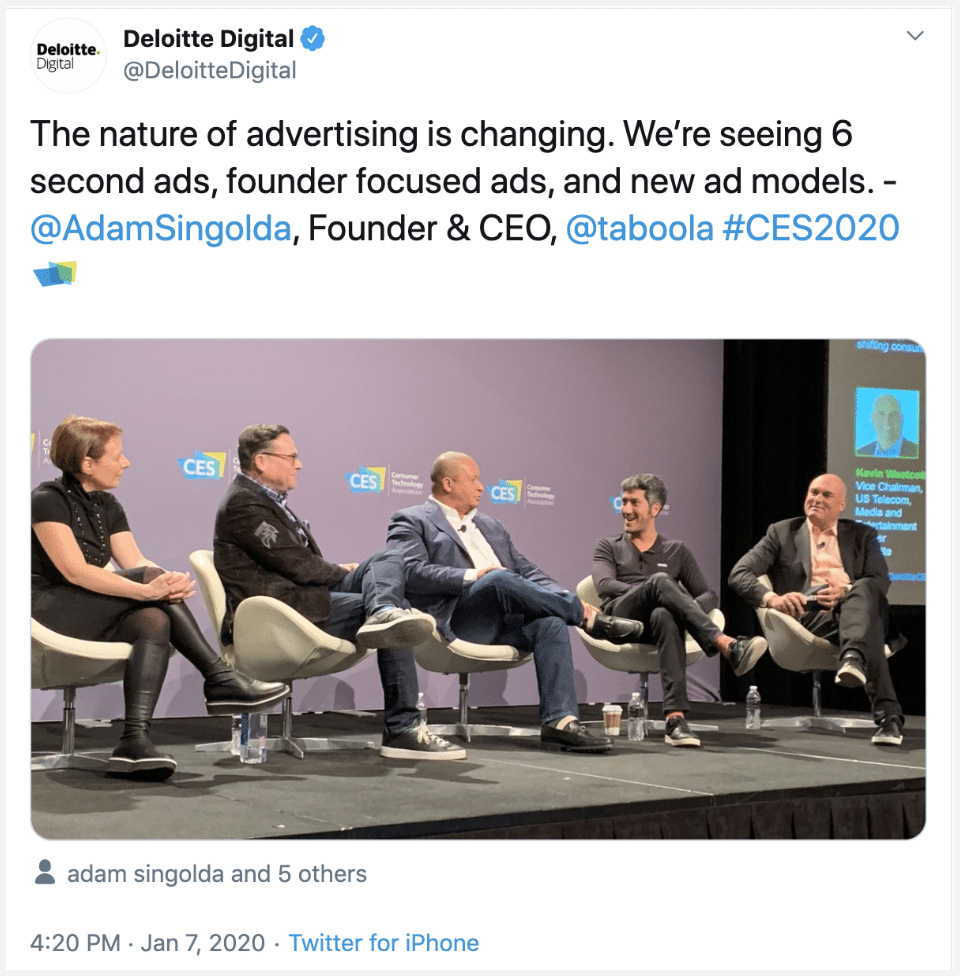Today, humans are more connected than ever before. They’re connected in their homes, they’re connected in their cars, and with smartphones in their hands or pocket, they’re connected every place they go. And that connectivity is far from slowing down.
Amidst self-driving cars and impressive robots at 2020’s Consumer Electronics Show (CES), Taboola’s Founder & CEO, Adam Singolda, joined a panel moderated by Kevin Westcott of Deloitte alongside Mark Garner of A+E Networks, Jesse Redniss of WarnerMedia, and Christy Tanner of CBS News Digital to discuss the future of entertainment in a constantly connected world.
Through all of the topics they explored, a common thread came into focus: evolution.
The way entertainment content is created and the way content is consumed will always evolve alongside one another, giving a nudge to the other when one starts to get ahead, and vice versa.
Here, we’ll dive into the way that the four panelists see this evolution, and explore some of the predictions they brought to light.

How will the Connected Ecosystem Evolve?
According to panelists, eventually, the walled gardens will have to take their walls down.
Westcott kicked off the conversation with an imagined future where there’s 75 connected devices under one single roof.
With this future in mind, Redniss highlighted a move away from the “closed ecosystems we’ve become accustomed to navigating through.” A growing number of screens, devices, and ways to connect will create more competition in the ecosystem and require more collaboration.
How Will Content Evolve to Meet It?
Content is on its way to being more authentic and less templated. In the future, we’ll see content evolving to meet the platform.
Garner, speaking on behalf of television shows, explained:
“We’re used to half hour, hourlong slots––used to it being dictated by the clock, but that’s been obliterated.”
He went on to explain how storytellers have, and will continue to have, more outlets than ever before to continue to tell their stories. They can keep on telling it in an hour long format, but they can complement that with shorter content for YouTube, and other bite-sized content. He explained that there will be “a story for each one of us, just told differently.”
Tanner, digging into the future of news content, pointed out the topic of authenticity:
“The idea that everything has to be produced into a neat package is becoming an antiquated way of covering the news. People want to see for themselves––a speech while it happens, from start to finish.”

How will Ad-Supported Models Work in this Ecosystem?
Advertising will continue to be important, regardless of company size or success. As attention gets even shorter, content creators, brands and publishers alike will continue to need to get their content in front or the right audience at the right time.
“Attention is so important––we’re overconnected today, distracted, there’s too much going on. Capturing user attention is so valuable.”
Singolda went on to say that advertising is often misunderstood in today’s evolving ecosystem.
“If you were to ask me if I would prefer instagram with or without ads, I would choose with. I click on those ads, I buy those products. They delight me with new products and services I didn’t know existed. The trend is not that ads are bad––it’s that good, relevant advertising is…well…good.”
Singolda explained that creative elements of advertisements will also be evolving, with the rise of the six-second ad and the telling of founder stories. He urged companies to be ahead of, not behind, that trend to hold an advantage in the future connected ecosystem.
How will Advertising Evolve in Traditionally Ad-Supported Spaces?
News doesn’t face the same advertisement aversion as scripted shows. Advertising will evolve from salesy content to brand storytelling.
Tanner explained:
“There is a certain segment that would enjoy news without ads.”
She notes the possibility of exploring a tiered offering, with and without advertising, but stresses the importance that “telling stories about brands that are interesting to people is good content as much as it’s an ad.”
How Sustainable is Exclusive, Original Content in the Evolving Ecosystem?
With the amount of available content at any given moment on the rise, finding content that’s meaningful to one particular consumer will grow increasingly challenging. The creation of highly produced original content will act as a means to draw the consumer in, and lead them to a place where more content can be recommended to them.
Garner said:
“Big, epic shows will continue to grow because they get people in the door. You then need other content that people will stay for. We can’t forget that there’s a significant appetite for entertainment.
It’s one of the few things that people are always going to need, want, and pay for voraciously, and the diversity and breadth of content will only grow.”
Redniss stressed the importance of helping people find “the content that’s meaningful to them,” and said that consumers select entertainment because it brings them “happiness, sadness, and into a moment they want to share when they receive a storyteller’s message.”
How is Discovery Evolving to get the Right Content in Front of the Right Audience?
The evolution of discovery will hinge on an artful balance of human creation and increasingly powerful, but responsible, machine learning and AI.
“Currently at Taboola, we recommend content to 1.5 billion people,” Singolda shared. “Jeff Bezos said ‘it’s hard to build trust but easy to ruin it’. The value of a good recommendation is very important.”
Singolda shared a relevant study conducted by Taboola:
“We tested this out with 50 married people. You think your spouse should know your likes and dislikes and might be able to predict what you would like to do, watch, or read right? Well, we gave content options to one spouse and asked them to predict which of the options their spouse would be most likely to click on to read or watch next.
Taboola, not knowing this person at all, also predicted. This was done three times. The first time, the spouse was right and Taboola was wrong. The second time, the spouse was right and Taboola was…less wrong. The third time though, Taboola was right more often than the spouse. AI makes these types of predictions better.”
Machine learning and AI, of course, don’t come without the need for careful curation, and thoughtful recommendations. The panelists agreed unanimously on this, with Redniss pointing out that “technology is an accelerator for curation.”
What role will 5G play in the Ecosystem’s Evolution?
5G dominated discussions and predictions at CES 2020, and its entrance into ubiquitousness will undoubtedly help information spread faster, improve consumer experiences, and a host of other impacts unimaginable today.
Regarding 5G and news programming, Tanner said:
“Speed of information, in life or death situations, is so important. We’re hopeful that 5G will help get that message out faster. Consumer experiences will get better,” said Redniss, “there will be more bundling.”
He went on to give the example of an NBA game, with video experience, 40 other points of view at the game, an AR/VR experience, a video game experience––5G’s speed will lead to more and more use cases.
“Not knowing what’s next is what’s beautiful about innovation,” said Singolda. He reminds the audience that when the internet was first invented, the possibility of streaming music didn’t exist, so there are a lot of unknowns around what 5G could bring to consumers next.
How will Trust Shape the Future Ecosystem?
The importance of trust is only getting larger as more information enters the connected ecosystem, and it can often be the determining factor in a consumer’s choice.
Tanner pointed out:
“Last year, trust in media went down, but when that was separated out into search, social, and traditional media, they found that trust for traditional media was much higher than that for search or social.”
Singolda, in agreement, went on to say:
“Trust will become important to journalism to attract ad dollars over social networks and walled gardens. There’s a huge opportunity for advertisers to choose to either fund social networks or fund local journalism.
CBS news is a trusted environment, and it’s viewed as better to put money there than it is with social networks.”
What About Sports and Other Live Entertainment? How will They Evolve?
The draw of live entertainment won’t fade away as more and more content becomes on-demand, but it will layer on more experiences and capabilities to create immersive, connected experiences.
Garner began by saying that “live programming will continue to drive cable’s value” because, be it a sporting event or just a pop culture moment, people don’t want to miss out on consuming that event in realtime.
Redniss added that “fandom has different formats, and technology takes it the experience off the court or field,” alluding to the fact that while traditional sports content may stay traditional, technology will allow for the experience to evolve in a number of different ways.
And the same holds true for news, as Tanner said:
“We live in a global, 24/7 news world now. Global, live stories unfold. It’s building a live ecosystem.”
The Future Ahead
To bring the panel to a close, Westcott asked each panelist to look into their crystal ball, and make a bold, five-year prediction. The panelists shared visions of using new technologies and new connective capabilities for good, and staying open to possibilities.
Tanner said:
“More recognition among all those who are defined as media so that they are responsible for the content that is delivered on their platforms––especially with the crisis in the world of information with trusted information vs. manipulated information. I hope all the responsible parties in the media ecosystem realize we have to work together.”
And from Redniss:
“In order to progress, identity in our operability is important. On the advertiser side, the publisher side, and the consumer side. How we define identity will help dictate the cross-capability of taking someone from four to 75 different connected devices, and having every one of them know your preferences and how you consume content.”
Garner mused:
“A connectedness through everything––seamless and frictionless, where you don’t have to set it up again and re-interpret it. All of our touchpoints connected.”
And Singolda’s prediction:
“Physical devices will save journalism. We’ll see new companies integrating news as a service and a feed across all industries. Every car will be sold with a news feed in it that you can scroll or listen to. Every fridge will have an interface. Companies will send users to premium content beyond search and social.”
Westcott, in a future hope of his own, focused on technologies with the power to improve quality of life.
“There are devices that can detect early stage diseases, years before traditional tests. I think about the ability for us to help educate those who don’t have access to traditional education. That’s what keeps me excited.”
The level of connectivity humans have access to, and the devices they connect on, are only growing as the future unfolds. Evolution is inevitable, but if this panel is any indication, the future of the connected ecosystem is in good hands.